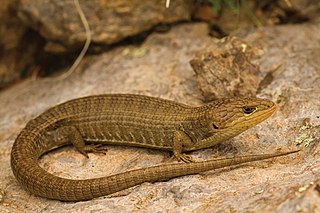
Laemanctus is a genus of lizards in the family Corytophanidae. Species in the genus Laemanctus are commonly referred to as conehead lizards or casquehead iguanas. The genus is endemic to Central America.

Spiny lizards is a common name for the genus Sceloporus in the family Phrynosomatidae. The genus is endemic to North America, with various species ranging from New York, to Washington, and one occurring as far south as northern Panama. The greatest diversity is found in Mexico. This genus includes some of the most commonly seen lizards in the United States. Other common names for lizards in this genus include fence lizards, scaly lizards, bunchgrass lizards, and swifts.

Abronia is a genus of lizards in the family Anguidae that is native to Mexico and Central America. The majority of the species are restricted to southern Mexico and Guatemala, but members of the genus occur as far south as Panama. They inhabit forests and woodlands, mostly in highlands, and some species are often associated with bromeliads. They are typically arboreal, but there are also terrestrial Abronia species. Many species are considered threatened due to habitat loss, killing by locals who mistakenly believe they are venomous, or collection for the captive reptile trade. They feed on small animal prey, such as insects, and the females give birth to live young.

Gerrhonotus is a genus of anguid lizards that are commonly referred to as alligator lizards, due to a vague resemblance to an alligator. Most species are restricted to Mexico, but a few range into Guatemala or Texas, and G. rhombifer is from Costa Rica and Panama. Along with glass lizards (Ophisaurus) and many other lizards, alligator lizards have the ability to regrow their tail.

Gerrhosaurus is a genus of lizards native to southern and eastern Africa.

The northern alligator lizard is a species of medium-sized lizard in the family Anguidae. The species is endemic to the North American west coast.

Arend Friedrich August Wiegmann was a German zoologist and herpetologist born in Braunschweig.

Abronia chiszari, Chiszar's arboreal alligator lizard, is an endangered species of arboreal alligator lizard in the family Anguidae. The species is native to east-central Mexico.

Abronia deppii, Deppe's arboreal alligator lizard, is an endangered species of arboreal alligator lizard in the family Anguidae. The species was described in 1828 by Arend Friedrich August Wiegmann, and it is endemic to Mexico.

Cnemidophorus deppii, known commonly as the blackbelly racerunner, is a species of lizard in the family Teiidae. The species is native to Central America and southern Mexico. There are three recognized subspecies.

Aspidoscelis sackii, known commonly as Sack's spotted whiptail, is a species of lizard in the family Teiidae. The species is endemic to Mexico. There are three recognized subspecies.

Abronia gadovii, also known commonly as Gadow's alligator lizard and el escorpión de Gadow in Mexican Spanish, is a species of lizard in the family Anguidae. The species is endemic to the highlands of the Sierra Madre del Sur in Guerrero and Oaxaca, Mexico. Two subspecies are recognized:
The Sierra alligator lizard or imbricate alligator lizard is a species of medium-sized lizard in the family Anguidae. The species is endemic to Mexico.
There are three species of lizard named imbricate alligator lizard:

Herrera's alligator lizard is a species of medium-sized lizard in the family Anguidae. The species is endemic to Mexico.

The imbricate alligator lizard or transvolcanic alligator lizard is a species of medium-sized lizard in the family Anguidae. The species is endemic to Mexico.

The Chihuahuan alligator lizard is a species of medium-sized lizard in the family Anguidae. The species is endemic to Mexico.
The Oaxaca alligator lizard is a species of medium-sized lizard in the family Anguidae. The species is endemic to Mexico.

The rough-necked alligator lizard is a species of medium-sized lizard in the family Anguidae. The species is endemic to Mexico.

















